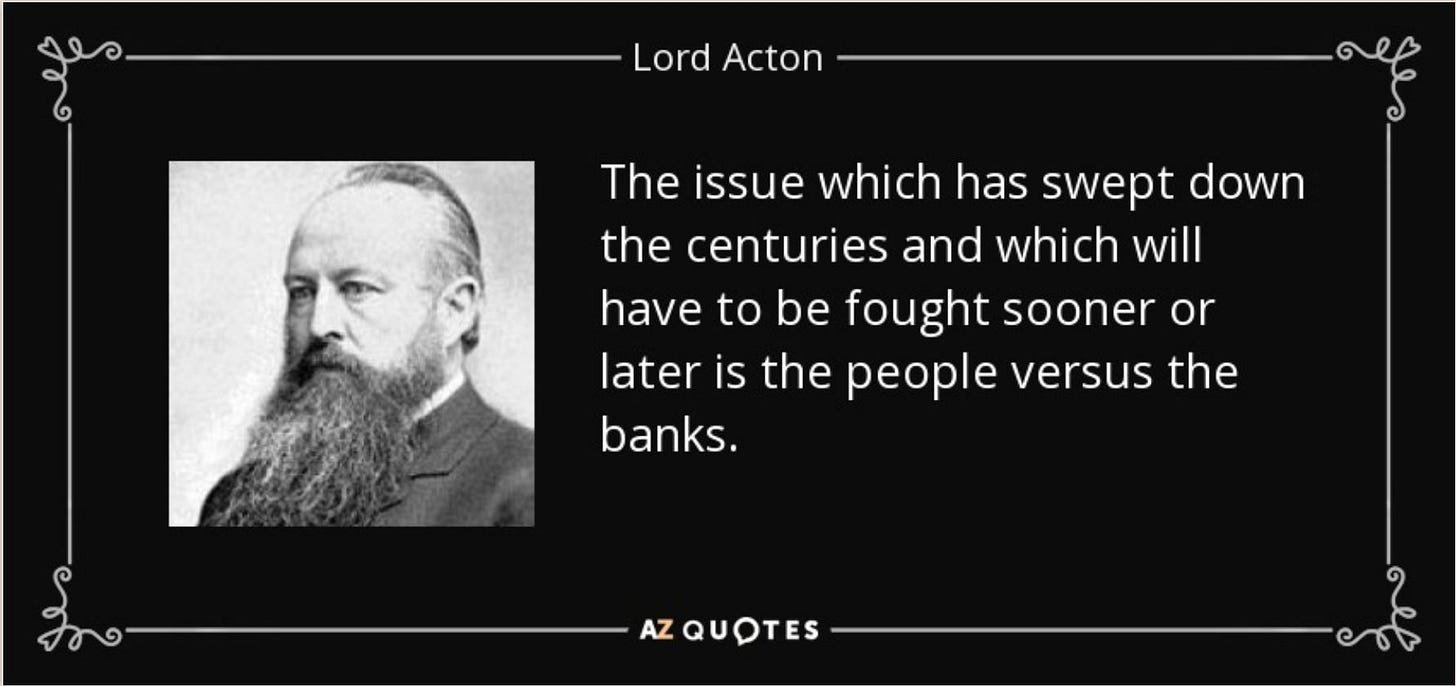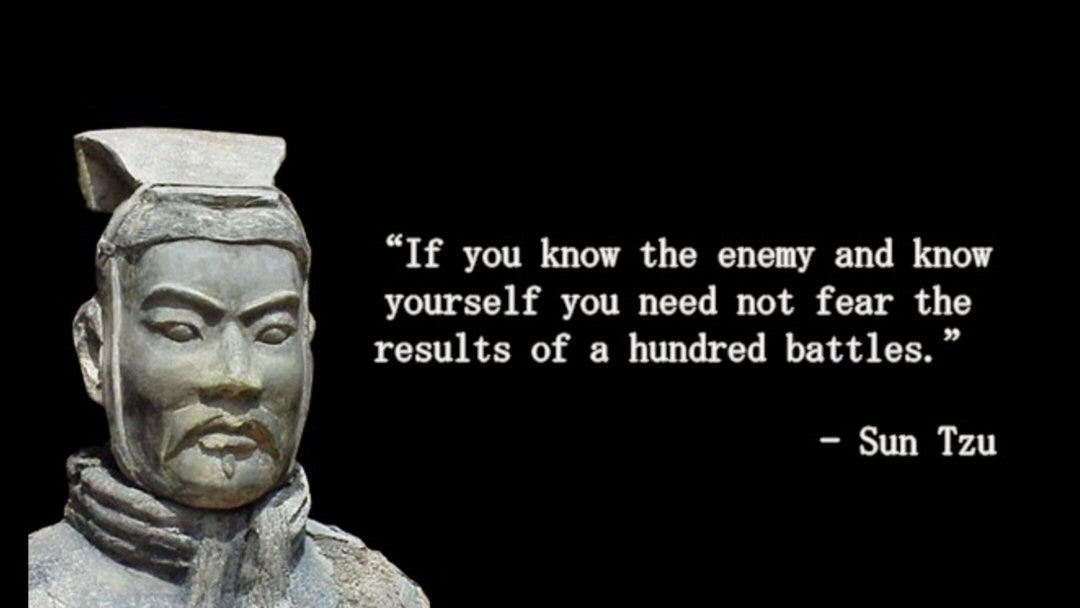#9 - "Bank" credit or "Social" credit??
100 years of frustration explained: "a riddle, wrapped in a mystery, inside an enigma". (~9 minute reading time)
“There can be only one (form of credit)!”
About 100 years ago, C.H. Douglas raised the hopes of many with his ideas about “social credit”. His followers began to see the possibility of imposing social control on banks, whose centuries-old “monopoly of credit” has allowed them to cause economic booms and busts by expanding and contracting the 97% of the money supply that banks “issue”.
Indeed, when Douglas arrived on the scene it seemed the battle predicted by Lord Acton1 had begun.
“The issue which has swept down the centuries and which will have to be fought sooner or later is ‘The People versus The Banks’”.
However, after 100 years, the Social Credit movement still struggles to get its message out to the public, while banks still issue 97% of the world’s money supply.
Indeed, since the Chinese Communist Party hijacked its name in 2014, and despite the efforts of its enthusiastic leaders and members, the Social Credit movement has been “marching on the spot” rather than advancing, virtually in survival mode.
So, have the banks won the battle for supremacy??
Almost, but not quite. The movement can still snatch victory from the jaws of defeat if it studies “The Art of War”, learns the true nature of the people it’s up against, and develops a more invigorating message that the beleaguered public is itching to hear.
Know Your Enemy
The legendary Chinese military general, Sun Tzu, knew the folly of engaging an enemy you don’t know, and lack of first-hand knowledge about banks’ internal accounting operations has effectively ceded the “military advantage” to the bankers, who do know our behaviours and vulnerabilities and exploit them to their own advantage. Our ignorance of their Modus Operandi turns out to be their most effective weapon against us.
Not to put too fine a point on this, the monetary power exercised by banks has attracted power-hungry, sociopathic liars who quickly learned from Sun Tzu’s “The Art of War”. For centuries, they’ve honed the skill of “appearing strong when weak” and kept their plans “dark and impenetrable as night”, concealing the criminality of their fraudulent practices with “a riddle, wrapped in a mystery, inside an enigma” (pace Winston Churchill).
A sociopathic banker will enjoy deceiving every “borrowing” customer with false accounting. He has neither sympathy, for those whose lives he can destroy on a whim, nor qualms about the damage his lies do to honest people. Exercising power and indulging his self-interest are his supreme pleasures and anyone who gets in his way can be destroyed by using the “power of money”, which he creates at will.
The Path to Victory
At present, the verbal weapons of Social Credit don’t affect such well-disciplined, long-experienced, battle-hardened, sociopathic liars. The broad scope of Social Credit’s grammar unwittingly spreads those efforts thinly and in too many directions. The very breadth of his vision obstructed Douglas’ view of the bankers’ accounting fraud 100 years ago and that same unfocused vision remains today.
By contrast, the bankers’ accounting grammar focuses sharply on “lending credit (fraudulently)” and gives bankers a decided advantage over the scatter-gun approach of Social Credit, which Douglas defined as, “the policy of a philosophy” that teaches a “method of thinking” about all kinds of economic and political problems caused by “the monopoly of credit”.
Dare I suggest that the movement’s message would be more engaging and effective if it focussed on eliminating the cause of those well-described problems, rather than teaching a “method of thinking” about them? Given time, anybody suffering the effects of those problems could also describe them correctly, but the description of a problem is only the first step towards a solution. What the public desperately wants and needs is an equally precise description of the cause of the problems, because the most efficient and effective solution is the one that eliminates the cause of those problems.
On the other hand, fluency in the bankers’ accounting grammar exposes chapter and verse of their sinister magic, which causes the economic and social damage that so enraged Douglas in the first place.
Like Douglas, most “borrowers” can sense that their bank is taking advantage of them and, though they feel the injustice, they simply can’t fathom, let alone prove, the fraud in the bank’s accounting. Again, like Douglas, I’ve also spent too many years looking in all the different directions Douglas was pointing, while the accounting solution was so close to me that I couldn’t see it until I focussed on learning the bankers’ language.
The Awakening: All credit balances in a bank are “social credit balances”, which can’t be lent!
Social Credit leaders are aware of the axiomatic truth of the astonishing 2014 revelation by the Bank of England: that all credit balances are bank liabilities and only assets can be lent; so, bank liabilities can’t be lent.
I've discussed that revelation in detail in this article #4:
I see this new evidence, handed to us by the Bank of England, as the most significant development for the Social Credit movement in recent years. It doesn’t contradict Douglas but provides the movement with a more powerful weapon than Douglas could ever have constructed.
It remains to be seen whether social crediters understand the full power of this new weapon and, if they do, whether they are prepared to use it to attack their opponent’s most vulnerable weak spot: the thinly disguised accounting fraud of “lending credit”.
Given the speed of the bankers’ advance towards their ultimate goal and the short distance to that goal, delaying that attack could be disastrous.
A new, practical “social credit” narrative: “Bank credit” is ALWAYS social credit, a customer’s asset!
Because every credit balance in every bank is an asset of someone outside the bank, every such credit balance deserves the title “social credit balance”. That title emphasises its true ownership, not by the banker but by a member of society.
For the first time, this establishes a new practical meaning of “social credit” as a precise accounting adjective, rather than an ill-defined philosophical term unrelated to the practical accounting of a banker.
Historically, these customer assets have been called “bank credit” or “bank deposits” due to incessant repetition of those false names by bankers and their tame economist puppets. Even the much-cited 2014 Bank of England article above uses this misleading terminology.
But the simple accounting truth is that all credit balances in every bank account result from a customer’s deposit of a valuable item in a bank. It makes no difference whether that deposit was $100,000 in cash or a “promise to pay” $100,000, that customer’s deposit creates a $100,000 “social debit item”, the ultimate origin of the matching $100,000 “social credit item” and its $100,000 “social credit balance” in the banker’s accounts.
When ownership is correctly assigned, all existing Social Debit balances belong to the banks and all Social Credit balances belong to bank customers.
When this ownership split is legally recognized, public pressure can be applied to enshrine that split categorically, once and for all. At that point, the battle for social control of banks will have been “won without fighting” (as recommended by Sun Tzu); we will no longer pay interest to “borrow” from banks the Social Credit balances we already own, which we created by depositing our inherently valuable Social Debit items. The bankers’ fraudulently claimed ownership of ‘credit’ will have been annulled permanently.
The firmest possible foundation from which to project all of Douglas’ well-known policies is the knowledge that ordinary people have always owned individual pieces of that huge portion (~97%) of the world’s currencies residing in banks in the form of Social Credit balances. We’re talking about the largest part of the global money supply here; the trillions of Dollars, Rupees, Baht, Yen, etc., which already exist in billions of socially owned credit balances in ALL banks. Ownership of ALL such Social Credit balances must revert to their true owners, namely, the billions of bank customers who created them with their Social Debit deposits.
INTEREST-FREE Social Debit accounts
Only customers’ ignorance of accounting rules has allowed bankers to claim those “Social Credit balances” as the banker’s “bank credit” and pretend to lend them to society.
We now know they cannot do that without our willing acceptance of their lies as truth.
If you still need clear evidence of the banker’s accounting lie, I recommend reading my article #6, embedded here:
Accordingly, all such social debit balances will then be declared interest-free, which does not mean a customer is free of the obligation to “keep the promise made” to establish the social debit item and its matching social credit item. But it does mean “debt-free” because that obligation is “self-imposed”. The banker, as the bookkeeper, has no legal right to enforce it because no asset of the bookkeeper has been transferred to the customer. It was the customer’s “promise-to-pay” that created both the social debit item and its matching social credit item in the book.
Mortgages, Honouring the Promise, & Bank Fees
MORTGAGES: As no pre-existing bank asset is involved, no debt attaches to this “social debit balance obligation”. So, there is no basis for taking a security interest [mortgage] over any real property. All punitive terms must be excised from existing bank “loan” contracts.
PAYMENT: The rate at which a “social debit balance” will be paid down should be decided by the promise-making customer unilaterally.
LEGITIMATE BANK FEES: Since reorganized banks will only charge (i) fees for entering transactions and (ii) monthly fees for maintaining the customer’s social debit and social credit accounts, fewer (larger) payments and faster pay-down of social debit balances will reduce the total fees paid, while more (smaller) payments and slower pay-down will mean higher total fees.
Ladies and gentlemen of the jury, you have seen the evidence against the accused. On the charge of “Fraudulent Accounting”, how say you: Guilty, or Not Guilty?
John Dalberg-Acton, 1st Baron Acton, or possibly (according to Ezra Pound) John Duke Coleridge, Lord Chief Justice of England in 1875.










The cause of this evil lending scam is as result of the PPP (Private-Public-Partnership) arrangement that has now morphed into the Progressive New Liberal (neoliberal) model of capitalism called cronyism. It is now standard practice where Government is a protection partner in crime with the Banksters and is hidden from scrutiny. My personal view.
I wished you lived near me Pat. I'd be visiting you often. It's reading your work which is filling some gaps that I know I have. Great work. All of it.
"because the most efficient and effective solution is the one that eliminates the cause of those problems."
I feel like I'm reading an engineer.